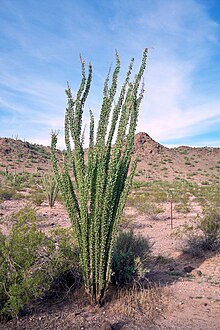| Ocotillo | |
|---|---|

| |
| Ocotillo near Gila Bend, Arizona | |
| Scientific classification | |
| Kingdom: | Plantae |
| Clade: | Tracheophytes |
| Clade: | Angiosperms |
| Clade: | Eudicots |
| Clade: | Asterids |
| Order: | Ericales |
| Family: | Fouquieriaceae |
| Genus: | Fouquieria |
| Species: | F. splendens
|
| Binomial name | |
| Fouquieria splendens | |
| Synonyms[2] | |
|
Fouquieria spinosa Torr. | |
Fouquieria splendens (commonly known as ocotillo /ɒkəˈtiːjoʊ/ (Latin American Spanish: [okoˈtiʝo]), but also referred to as buggywhip, coachwhip, candlewood, slimwood, desert coral, Jacob's staff, Jacob cactus, and vine cactus) is a plant indigenous to the Mojave Desert, Sonoran Desert, Chihuahuan Desert and Colorado Desert in the Southwestern United States (southern California, southern Nevada, Arizona, New Mexico, Texas), and northern Mexico (as far south as Hidalgo and Guerrero).[3][4]
While semi-succulent and a desert plant, Ocotillo is more closely related to the tea plant and blueberries than to cactuses. For much of the year, the plant appears to be an arrangement of large spiny dead sticks, although closer examination reveals that the stems are partly green. With rainfall, the plant quickly becomes lush with small (2–4 cm), ovate leaves, which may remain for weeks or even months.
Individual stems may reach a diameter of 5 cm at the base, and the plant may grow to a height of 10 m (33 ft). The plant branches very heavily at its base, but above that, the branches are pole-like and rarely divide further. Specimens in cultivation may not exhibit any secondary branches. The leaf stalks harden into blunt spines, and new leaves sprout from the base of the spine.
The bright crimson flowers appear especially after rainfall in spring, summer, and occasionally fall. Flowers are clustered indeterminately at the tips of each mature stem. Individual flowers are mildly zygomorphic and are pollinated by hummingbirds and native carpenter bees.

Ocotillo occurs in desert regions of southwestern United States through central Mexico. It grows in dry, generally rocky soils.[5]

Ocotillo can be planted year-round with care. Ideal plants have been grown in pots from stem cuttings and from seed. Transplanting large bare-root plants has marginal success. They should be planted to the original growing depth and, as with cacti, in their original directional orientation: the original south side of the plant, which has become more heat- and sunlight-resistant, should again face the brighter, hotter southern direction. If their direction is not marked, success is again limited.[citation needed]
The three subspecies are: